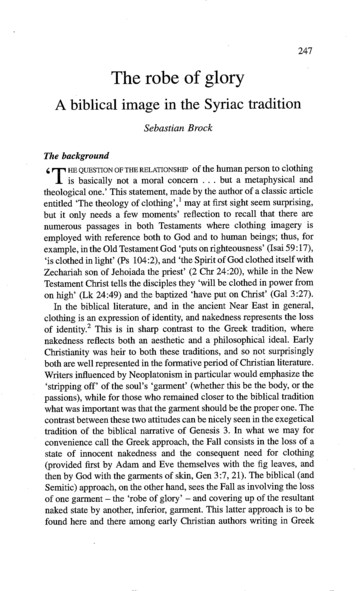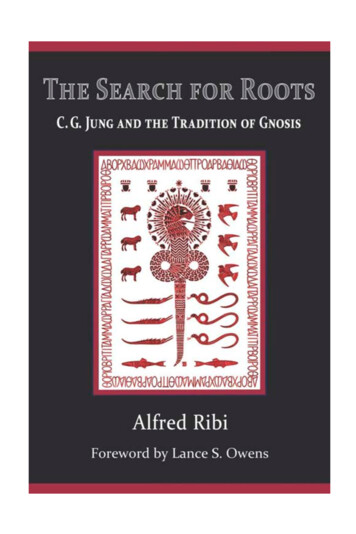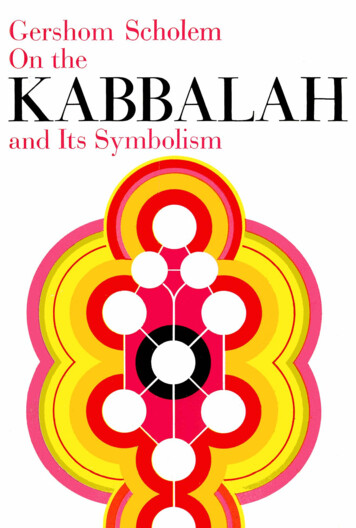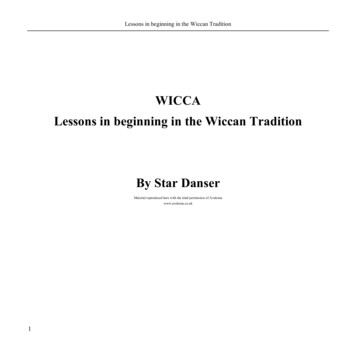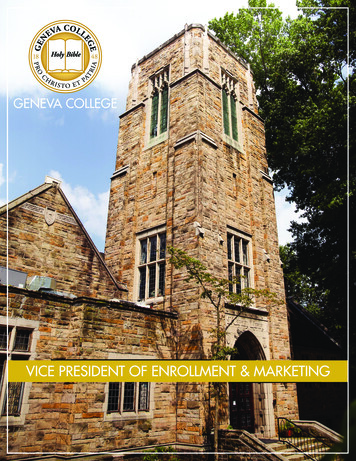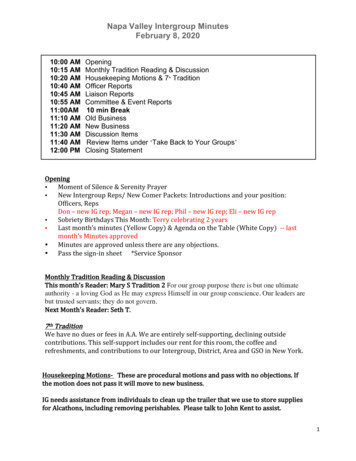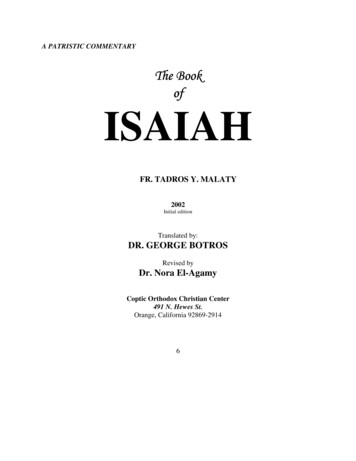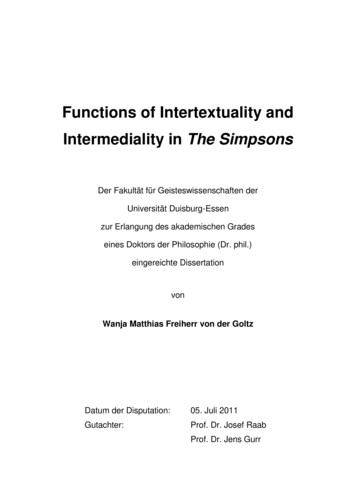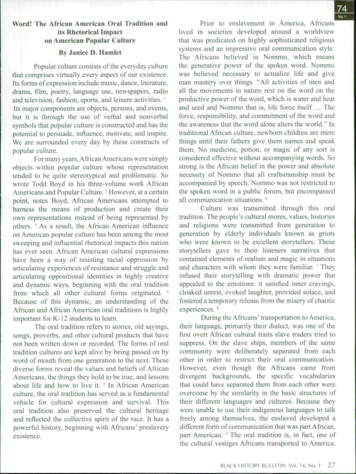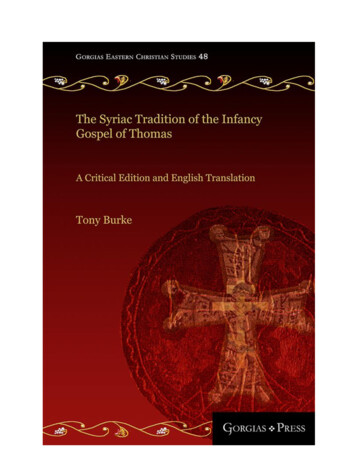
Transcription
The Syriac Tradition of the InfancyGospel of Thomas
Gorgias Eastern Christian Studies48Series EditorsGeorge Anton KirazIstván PerczelLorenzo PerroneSamuel RubensonGorgias Eastern Christian Studies brings to the scholarly world theunderrepresented field of Eastern Christianity. This series consistsof monographs, edited collections, texts and translations of thedocuments of Eastern Christianity, as well as studies of topicsrelevant to the world of historic Orthodoxy and early Christianity.
The Syriac Tradition of the InfancyGospel of ThomasA Critical Edition and English TranslationTony Burkegp2017
Gorgias Press LLC, 954 River Road, Piscataway, NJ, 08854, USAwww.gorgiaspress.comCopyright 2017 by Gorgias Press LLCAll rights reserved under International and Pan-American CopyrightConventions. No part of this publication may be reproduced, stored in aretrieval system or transmitted in any form or by any means, electronic,mechanical, photocopying, recording, scanning or otherwise without theprior written permission of Gorgias Press LLC. ܘ 12017ISBN 978-1-4632-0584-3ISSN 1539-1507Library of Congress Cataloging-in-Publication DataNames: Burke, Tony, 1968- author.Title: The Syriac tradition of the Infancy Gospelof Thomas : a criticaledition and English translation / Tony Burke.Other titles: Gospel of Thomas (Infancy Gospel).Syriac. Gospel of Thomas(Infancy Gospel). English.Description: Piscataway, NJ : Gorgias Press,2017. Series: Gorgias EasternChristian studies ; 48 In English; originaltexts in Syriac; withtranslations into English. Includesbibliographical references and index.Identifiers: LCCN 2017025498 ISBN 9781463205843Subjects: LCSH: Gospel of Thomas (Infancy Gospel) Gospel of Thomas (InfancyGospel)--Criticism, Textual.Classification: LCC BS2860.T4 A1 2017 DDC229/.8--dc23LC record available athttps://lccn.loc.gov/2017025498Printed in the United States of America
TABLE OF CONTENTSTable of Contents . vForeword . viiAbbreviations . xi1 History of Scholarship . 12 Descriptions and Classification of the Manuscripts .251 Recension A .251.1 Related Tradition: Arabic Infancy Gospel of Thomas .512 Recension W (West Syrian) .532.1 Group a .552.2 Group b .672.3 Group c.742.4 Additional Life of Mary Manuscripts . 812.5 Garšūnī Manuscripts .843 Recension E (East Syrian) .883.1 East Syriac Hist. Vir. Manuscripts with IGT .933.2 East Syriac Hist. Vir. Manuscripts without IGT .983.3 Additional Hist. Vir. Manuscripts.1103.4 Related Texts and Traditions: Arabic Infancy Gospeland Armenian Infancy Gospel .1123 Texts and Translations.123Recension Sa.126Recension Sw .170Recension Se .212Arabic Infancy Gospel of Thomas .2294 Synopsis.2455 Glossary .291Bibliography .311Index .329v
vi
FOREWORDThe Infancy Gospel of Thomas (IGT) is believed to be one of theearliest texts of the Christian apocrypha. Irenaeus and the author ofthe Epistula Apostolorum seem to have known it in the late secondcentury and, unlike many apocryphal texts, which routinely expandand interact with the texts of the canon, it contains few parallels orallusions to the canonical Gospels. Yet IGT is rarely taken seriouslyas a witness to early Christian understandings of Jesus. Its depictionof Jesus’ childhood would seem to have little connection to thehistorical Jesus, its Christology is difficult to associate with earlyheretical groups, and its portrayal of the young wonderworkercursing his playmates and teachers is offensive to modernsensibilities. Nevertheless IGT is extremely important for Christianpiety—its stories spread throughout both the churches of the West,principally via the Gospel of Pseudo-Matthew, and the churches of theEast, due largely to the Syriac Life of Mary compendia, and fromthese texts the stories were transformed into art, iconography,plays, hymns, and other forms of devotion.IGT was known in Syriac speaking lands by at least the fifthor sixth century—the time of the earliest known manuscript,published over a century and a half ago by William Wright.Scholars interested in reconstructing the original text of the gospeldid not immediately see the value of the Syriac tradition; so it tooksome time before the tradition was given the attention it deserved.A few other witnesses were published sporadically in the decadessince Wright’s textus receptus, but no one, until now, has endeavoredto assemble all of the known published and unpublishedmanuscripts into a formal critical edition.It is clear from the number of manuscripts that IGT was avery popular text in the Syriac churches. Though it is found as aseparate text in only a few manuscripts, it had a much richer life aspart of collections of apocryphal texts featuring episodes from thevii
viiiSYRIAC INFANCY GOSPEL OF THOMASlife of the Virgin Mary. One branch of this tradition, the WestSyriac Life of Mary, is examined here from 19 Syriac manuscriptsand another 13 in Garšūnī. Another effort to collect Mary-relatedapocrypha is found in the East Syriac History of the Virgin, known in21 manuscripts, though only four of them incorporate IGT. Manyof the manuscripts containing the two Life of Mary compendiaseem to have been created specifically for use in Marian piety, asthey often contain additional Mary-related texts, including hymnsand miracle stories. And these books of Mary were copied well intothe nineteenth century. For many Syriac Christians then, these textscontained acceptable depictions of Jesus’ childhood years; theywere neither frivolous nor blasphemous.In some ways the Infancy Gospel of Thomas in the Syriac Traditionfunctions as a supplement to my earlier edition of the Greektradition of IGT published in the Corpus Christianorum SeriesApocryphorum in 2010. Along with critical editions andtranslations of the four Greek recensions, that volume contains acomprehensive overview of previous scholarship and a discussionof how the text reflects idealistic views of children in antiquity. Thepresent volume follows a similar model, with a shortened summaryof scholarship focusing only on the Syriac tradition followed by adetailed description of the manuscripts, editions and translations ofthe Syriac manuscripts divided into three recensions, and a synopsisof these recensions for ease of comparison. Rounding out the bookis a glossary and an edition and translation of a little-known Arabictranslation of the Syriac tradition based on one complete and onefragmentary manuscript.Additional manuscripts of the three recensions are likely to bemade available after the publication of this volume; indeed, theeditions have been revised several times over the years as newsources became known. Readers interested in keeping track of newdevelopments can consult the online resource e-Clavis: ChristianApocrypha, which features manuscript listings and other resourcesfor a wide range of apocryphal texts. Look for links to the InfancyGospel of Thomas, the Life of Mary (West Syriac), and the History of theVirgin (East Syriac).This project has been almost a decade in the making. I havemany people to thank for their help along the way. First, to GeorgeKiraz and Melonie Schmierer-Lee of Gorgias Press for acceptingthe book for publication, for waiting patiently through years of
FOREWORDixdelays, and for guiding it through the publication process; to theSmall Grants Program at York University for sponsoring amanuscript-gathering trip to Union Theological College, Princeton,and Harvard and to my daughters, Meghan and Sophie, for comingalong for the ride; to all of the libraries and librarians for theirassistance, including Michelle Chesner (Norman E. AlexanderLibrarian for Jewish Studies at Columbia University), and ColumbaStewart and Adam McCollum at the Hill Museum and ManuscriptLibrary; and to Alain Desreumaux and Charles Naffah forsupplying me with copies of manuscripts.I am grateful to several colleagues who, in sharing theirexpertise on Syriac texts and traditions, greatly increased the depthof the volume and helped prevent a legion of embarrassing errors.Thank you Charles Naffah, Fr. Louis-Marie Ariño-Durand, andStephen Shoemaker, my fellow investigators of the Syriac Life ofMary literature; and Stephen J. Davis, Stephen Gero, and RobertCousland, each of whom have made their own significantcontributions to studying IGT; and also F. Stanley Jones, SebastianBrock, James Coakley, James Walters, Kristian Heal, AdamMcCollum, and Thomas A. Carlson for guiding me through thevagaries of Syriac Christianity. Most of all I thank Slavomír Céplöfor contributing the edition and translation of the Arabic IGT, forhis assistance with the Garšūnī manuscripts, and for hisindefatigable patience in answering requests for help too numerousto mention. Slavomír and I began collaborating in 2008, first on anedition of the Legend of the Thirty Pieces of Silver, and subsequentlymore informally assisting each other on our individual projects. Atthis point, I have benefitted far more from our relationship than hehas and this volume would not have been possible without him.Ďakujem ti, môj priateľ.Finally, I dedicate this volume to my wife, Laura Cudworth.Our relationship began at the start of my work on this project andshe has supported me every step of the way to its completion,including the time she came to my defense when a misbehavingscholar sought to hinder my access to the source materials. Thanksfor having my back.ix
vi
ABBREVIATIONSANCIENTActs Pil.ApameaApoc. PaulApocr. Gos. JohnArab. Gos. Inf.Arm. Gos. Inf.Bk. BeeDeathDepartureDorm. Vir.Ep. Chr. Heav.Haer.Hist. Phil.Hist. Vir.IGTActs of PilateMiracle of the Theotokos in the Cty of ApameaApocalypse of PaulApocryphal Gospel of JohnArabic Infancy GospelArmenian Infancy GospelSolomon of Basra, Book of the BeeJacob of Serug, On the Death and Burial of the VirginTimothy, bishop of Gargar, On the Departure ofMaryDormition of the VirginEpistle of Christ from HeavenIrenaeus, Adversus haeresesHistory of Philip in the City of CarthageEast Syriac History of the VirginInfancy Gospel of ThomasGa Greek A recensionGb Greek B recensionGd Greek D recensionGs Greek S recensionEth Ethiopic versionGeo Georgian versionIrIrish versionLM The first Latin version preserved in the parsaltera of the Gospel of Pseudo-MatthewLV The first Latin version preserved in Vienna,Nationalbibliothek, lat. 563 (5th cent.)LT The second Latin versionSyr Syriac versionxi
xiiLife MaryMaliceProt. Jas.Ps.-Mt.Quest. Bart.6 Bks. Dorm.Trans. Vir.Vis. Theo.SYRIAC INFANCY GOSPEL OF THOMASWest Syriac Life of MaryPseudo-Ephrem, On the Malice of the Jews againstMary and JosephProtevangelium of JamesGospel of Pseudo-MatthewQuestions of BartholomewSyriac Six-Books Dormition of the VirginTransitus VirginisVision of TheophilusMODERNBHOCANTCPGBibliotheca Hagiographica Orientalis. Edited by PaulPeeters, Subsidia Hagiographica 10 (Brussels: Sociétédes Bollandists, 1910).Clavis apocryphorum Novi Testamenti. Edited by MauriceGeerard, Corpus Christianorum (Turnhout: Brepols,1992).Clavis Patrum Graecorum. Edited by Maurice Geerard, 5vols. (Turnhout: Brepols, 1974–1987).
1HISTORY OF SCHOLARSHIPThe history of scholarship on the Infancy Gospel of Thomas has beentold previously, and in much detail. 1 The goal of this introductionis to narrow the focus specifically to work on the Syriac tradition ofthe text (hereafter, Syr), though with attention paid to how Syrrelates to the various other versions. To those who know IGT well,the importance of Syr is unmistakable, but it has not always beenso, and there are many readers of IGT even today who are unawareof the relationships between the sources and, by extension, Syr’scritical role in determining the text’s original form and meaning. Ofcourse, finding this elusive original form is not the only goal ofresearch. IGT has enjoyed a popularity in Syriac Christianityspanning at least 1500 years, but this is scarcely reflected inscholarship where it would appear that the Syriac text was only“rediscovered” in the nineteenth century. Readers should becautioned, therefore, that scholars’ interests are far different fromthose who read and cherished IGT in manuscript form. Theirstory, for now, remains largely untold.1. EARLY DISCOVERIES: GREEK, LATIN, ARABICThe usual telling of the history of IGT scholarship begins with thefirst published Greek MS: Paris, Bibliothèque nationale, ancienfonds gr. 239 (15th cent.). Excerpts from the MS appear in thenotes to Richard Simon’s Nouvelles observations sur le texte et les versionsdu Nouveau Testament from 1693; 2 three years later the text wasprinted in full by Jean Baptiste Cotelier. 3 The Paris MS is not1 Burke, De infantia Iesu euangelium, 45–126. On Syr in particular seeBurke, “Unpublished Syriac Manuscript,” 229–38; and Horn and Phenix,“Apocryphal Gospels in Syriac,” 537–44.2 Simon, Nouvelles observations, 5–9.3 Cotelier, SS. Patrum qui temporibus apostolicis floruerunt, vol. 1, 345–46.1
SYRIAC INFANCY GOSPEL OF THOMAS2complete: it features only IGT 1–5 followed by the beginning ofthe story of Jesus and the Dyer, an episode otherwise unattested inthe Greek tradition, but found also in Arab. Gos. Inf. (ed.Genequand) 35, Arm. Gos. Inf. 21, and several other sources. 4 ThisArab. Gos. Inf. made its scholarly debut around the same time as theGreek IGT in Heinrich Sike’s 1697 edition and Latin translation ofthe text from an undated and initially unidentified MS, 5subsequently revealed to be Oxford, Bodleian Library, Or. 350. 6The text repurposes portions of Prot. Jas. and expands the storywith additional traditions about Jesus’ birth and stories about theHoly Family’s sojourn in Egypt. Arab. Gos. Inf. is believed to be atranslation from Syriac (specifically, the East Syriac Hist. Vir. orone of its sources); Sike’s version is particularly significant as itincorporates a large portion of IGT, again, probably translatedfrom the Syriac. Additional sources for Arab. Gos. Inf. haveappeared since Sike’s day but they have not been translated intoEnglish. For many scholars, then, Arab. Gos. Inf. is known in theform published by Sike. 7For several centuries, most of the attention paid to IGT—indeed, to all available early apocrypha—focused on the Greek andLatin traditions. Recovery of the Greek text was significantlyadvanced by Giovanni Luigi Mingarelli’s 1764 publication ofBologna, Biblioteca Universitaria, 2702 (15th cent.), 8 the firstknown witness to the 19-chapter form of the text, which soonbecame dominant in scholarship. A similar MS, Dresden, SächsischeLandesbibliothek, A 187 (16th cent.), 9 was used along with theParis and Bologna MSS by Johann Karl Thilo for the first properThe story is included in certain Ukrainian IGT MSS (see Rosén,Slavonic Translation, 44), some MSS of the Latin Ps.-Mt., and was known toMuslim writers (on the latter two sources see James, Apocryphal NewTestament, 66–67).5 Sike, Evangelium Infantiae. English translation in Walker, ApocryphalGospels, 100–24; and Cowper, Apocryphal Gospels, 170–216. Bothtranslations were made from the revised Latin translation of Sike’s editionin Tishendorf, Evangelia Apocrypha, 181–209.6 Genequand, “Vie de Jésus en Arabe,” 209.7 For more discussion of Arab. Gos. Inf. see below pp. 111–18.8 Mingarelli, “Apocrypho Thomae Evangelio.”9 Thilo,Codex apocryphus Novi Testamenti, vol. 1, lxxiii–xci(introduction), 277–315 (text with Latin translation and notes).4
HISTORY OF SCHOLARSHIP3critical edition of the text in 1832. Thilo drew also on portions of afourth source—Vienna, Österreichische Nationalbibliothek, Phil.gr. 162 (144) (15th cent.)—noted in a 1675 catalog by PeterLambeck. 10 Unfortunately, the IGT portion of the Vienna MS hassince been lost; all that survives now are Lambeck’s extracts fromchs. 1 and 2. The same four Greek MSS were then used byConstantin Tischendorf in his influential Evangelia Apocryphacollection from 1853. Tischendorf christened Thilo’s 19-chapterversion Greek A (Ga) 11 in order to distinguish it from a shorterform of the text, Greek B (Gb), which he published from a singleMS found on his famous visit to St. Catherine’s monastery (Sinai gr.453, 14th/15th cent.). 12 Tischendorf’s collection also includesthree Latin versions of the text: an early translation from afifth-century fragmentary palimpsest (Vienna, ÖsterreichischeNationalbibliothek, lat. 563; LV), 13 a more recent translation thatfeatures a short prologue narrating the Holy Family’s activities inEgypt (based on Vatican, Biblioteca Apostolica, Vat. lat. 4578, 14thcent.; LT), 14 and two MSS of an expanded version of Ps.-Mt.( LM) that incorporates the Latin translation of IGT witnessedalso in the early palimpsest. 15The Ga text opens with an attribution to “Thomas theIsraelite philosopher,” presumably intended to mean the apostleThomas, though why Thomas, a figure often associated withunorthodox (some might say gnostic) forms of Christianity, waschosen as the author is somewhat mysterious. Based on thisattribution, early scholars of the text identified IGT as the “Gospelof Thomas” often mentioned and sometimes quoted by earlyChristian authors. 16 The problem with this identification is that theLambeck, Commentariorum, 270–73.Tischendorf, Evangelia Apocrypha, 140–57.12 Ibid., 158–63. Gb first saw publication in Tischendorf’s account ofhis Mt. Sinai expedition, “Rechenschaft über meine handschriftlichenStudien,” 51–53.13 Tischendorf, Evangelia Apocrypha, xliv–xlvi (published previously inDe evangeliorum apocryphorum, 214–15).14 Tischendorf, Evangelia Apocrypha, 164–80.15 Ibid., 93–112.16 For a comprehensive discussion of the early citations to the“Childhood of the Lord” and to the “Gospel of Thomas” see Burke, Deinfantia Iesu euangelium, 3–44.1011
SYRIAC INFANCY GOSPEL OF THOMAS4passages quoted from the “Gospel of Thomas” do not appear inIGT. This realization led to the creation of an expurgation theorythat explained the absences as a result of “orthodox revision”similar to the changes made over time to the apocryphal acts. Earlyscholarship focused also on IGT’s troubling portrayal of Jesus.Commentators objected to the stories of Jesus maiming andmurdering his Galilean neighbours, but they derived some comfortfrom the apparent progression in the young messiah’sdemeanour—the villagers demand that Joseph teach his son tobless and not to curse and, for the most part, their desires are met.After the teacher Zacchaeus’s lament in ch. 7, Jesus restores thosehe cursed to health, and then performs a number of praiseworthymiracles (chs. 9–18), broken only by the cursing of the secondteacher in ch. 14. The stories of chs. 10, 17, and 18 are of particularnote because they are structured very much like Synoptic miraclestories; in these tales, the young Jesus seems to be turning into theman familiar to readers of the canonical Gospels.Tischendorf’s Ga text has been very popular in scholarship; itsregular appearance in apocrypha collections, sometimes with Gband LT, has cemented its status as the textus receptus of IGT, aposition that has proved difficult to unseat despite subsequentadvances in establishing the text’s original form based on otherversions.2. SYRIAC MANUSCRIPTS AND SYRIAN ORIGINSThe first of these advances arrived in 1865 with William Wright’spublication of a Syriac MS from the British Library. The sixthcentury MS—London, British Library, Add. 14484 ( W) 17—predates the previously published Greek MSS by almost amillennium and contains striking differences from Tischendorf’sGa text. The introduction with its attribution to Thomas is lacking;thus the title of the text is simply “The Childhood of the LordJesus.” The Synoptic-like miracles of chs. 10, 17 and 18 also areabsent and in general, the remaining individual chapters are shorter,except for ch. 6, which is considerably expanded with material thatat this point in scholarship had been seen also in LT and LM butwas largely neglected due to the favoritism showed to Ga.17Wright, Contributions, ( ܝܐ–ܝܘ Syriac text), 6–11 (English translation).
HISTORY OF SCHOLARSHIP5Wright’s MS quickly made an impact on IGT scholarship.Tischendorf, for his part, incorporated its readings into theapparatus of the second edition of Evangelia Apocrypha. B. H.Cowper went a step further in his 1867 collection of apocrypha inEnglish translation. Alongside Tischendorf’s Ga text, Cowperplaced Gb, LT, and his own translation of W, 18 added because ofits antiquity and its agreements with the Latin palimpsest LV. 19Cowper stated also that he believed IGT may have been composedin Syriac. 20 The same opinion was held by Michel Nicolas, thoughNicolas, it seems, was unaware of the existence of Wright’s MS. InÉtudes sur les évangiles apocryphes, published in 1866, Nicolas outlineshis belief that all the infancy gospels were written by Syrian JewishChristians. 21 IGT’s Jewish-Christian features are said to include thetext’s esteem of James, certain geographical hints (e.g., playing onrooftops as in IGT 9), and affinities between IGT’s letterspeculation section (ch. 6:4) and similar practices in Kabbalah. 22Nicolas was the first scholar to present an explicit argument forSyriac composition. He cited the text’s attribution to Thomas—anapostle associated with Syriac Christianity via the Acts of Thomas 23—and the low quality of its Greek which, he claimed, owes itself toslavish translation from Syriac. 24 Many of Nicolas’s ideas aboutIGT were revisited by Jean Variot in his comprehensive 1878 studyLes évangiles apocryphes. 25 A Syrian origin was again postulated,though Variot was able to support his claim with Wright’s Syriactext, a text which he felt demonstrated signs of an earliertradition—it has fewer errors than the Greek and shows a concernfor the law (see ch. 6:2b). 2618 Cowper, Apocryphal Gospels, lxviii–lxxv (introduction), 128–69 (Ga,Gb, LT), 448–56 (Syr).19 Ibid., lxxv.20 Ibid., 128; cf. lxxii.21 Nicolas, Études sur les évangiles apocryphes.22 Ibid., 290–94.23 Ibid., 199.24 Ibid., 331.25 Variot, Les évangiles apocryphes.26 Ibid., 46–47.
6SYRIAC INFANCY GOSPEL OF THOMASA second Syriac source for IGT was published in 1899 by E.A. W. Budge. 27 During his travels in Syria, Budge commissioned acopy of a thirteenth/fourteenth-century manuscript from Alqošfeaturing the East Syriac Hist. Vir., a compilation of variousnoncanonical texts that prominently feature stories of Jesus’mother, beginning with Prot. Jas. and ending with Dorm. Vir. Muchof the material in-between, featuring tales of the Holy Family inEgypt, is found also in Arab. Gos. Inf., indicating that Budge’s text isan important witness to an earlier stage in the infancy gospel’sdevelopment. Budge published his Hist. Vir. based on twomanuscripts: the version from Alqoš that includes IGT as well asother expansions ( A), and a shorter version from a MS at theRoyal Asiatic Library (Syr. 1; B). Budge’s Alqoš MS is widelybelieved to be missing but that is not the case; it now resides in thelibrary of the University of Leeds (cataloged as Syr. 1). Perhaps thisbelief has contributed to the severe neglect of Hist. Vir. bysubsequent scholars. 28Syr next appeared in scholarship in Arnold Meyer’scontributions to Edgar Hennecke’s Neutestamentlichen Apokryphen indeutscher Übersetzung. 29 In the 1904 edition, Meyer notes thecorrespondences between the Latin and Syriac traditions, professestheir superiority over the Greek manuscripts, and concludes thatthe original text, “ohne Zweifel,” stood nearer to thesetranslations. 30 Meyer’s support of the versions is apparent in histranslation, which generally follows Ga but adds the Syriac andLatin translations in parallel columns where Meyer considered Ga27 Budge, History of the Blessed Virgin Mary, vol. 1, 67–76 (IGT materialin Syriac), vol. 2, 71–82 (in English). Budge also reprinted the Syriac textof W for comparison (vol. 1, 217–22).28 Aside from works by Paul Peeters, Elena Merscherskaja, and AntonPritula (surveyed below), the most comprehensive study of the text wouldbe Erica C. D. Frank’s unpublished 1974 Master’s thesis (“History of theBlessed Virgin Mary”), which examines Hist. Vir.’s use of other Syriacapocrypha and its possible influence on the Qur’an. A new edition of Hist.Vir. is being prepared by Louis-Marie Ariňo-Durand for futurepublication in the Corpus Christianorum Series Apocryphorum29 See Meyer, “Erzählung des Thomas” and the more in-depth studyin the accompanying Handbuch (“Kindheitserzählung des Thomas”[1904]).30 Meyer, “Kindheitserzählung des Thomas” (1904), 133.
HISTORY OF SCHOLARSHIP7to be deficient (chs. 5–8). For the second edition in 1924, Meyersupplemented his readings from W with another early MS fromGöttingen (Universitätsbibliothek, Syr. 10; 6th cent.; G). Meyerbecame aware of the manuscript via Hugo Duensing who mentionsit in a brief announcement made in 1911. 31 It was then noted byAnton Baumstark in his 1922 survey of Syriac literature. Baumstarkmentioned also several other unpublished MSS, all of which haveturned out to be witnesses to Budge’s Hist. Vir. 32 The full extent ofthe Göttingen MS was not revealed at the time, but readers wouldhave seen from Meyer’s 1924 translation that it includes materialfrom Ga 6–8 missing in W. The new MS reaffirmed Meyer’s beliefthat Syr represents an older text form than the Greek recensions. 33Unfortunately, it was many years before a full collation of G sawpublication.In the years between Meyer’s contributions to the Henneckecollections, Paul Peeters brought new interest to the Syriactraditions in his own Christian apocrypha collection, Évangilesapocryphes, co-edited with Charles Michel. The second volume,published in 1914, features an introductory essay by Peetersdetailing a comprehensive Syro-Arabian theory of origin for thevarious infancy gospel traditions. 34 To make his argument, Peetersdrew upon a new seventeenth-century MS (Vatican, BibliotecaApostolica, Syr. 159; dated 1622/1623; P) featuring Arab. Gos. Inf.in Garšūnī (Arabic in Syriac script) with IGT appended in Syriac.According to Peeters’s theory, all of the childhood stories found inthe infancy gospels derive from a larger collection of legendsassembled in Syriac in the fifth century. The IGT material, heclaimed, was soon detached from this collection and thentranslated into Greek and Latin. An intermediate Greek textbetween the Latin and Syriac texts was considered a possibility byPeeters but not a necessity. Peeters admitted the unlikelihood ofsuch a transmission process, but the greatest weakness in hisargument is his failure to offer any proof for his assertion of Syriaccomposition. He declared only that an inverse relationship fromIn Meyer’s telling (“Kindheitserzählung des Thomas” [1924], 93–94), the MS came from Sinai and was donated to Göttingen by Duensingwho announced the discovery in “Mitteilungen 58.”32 Baumstark, Geschichte der syrischen Literatur, 69 n. 12.33 Meyer, “Kindheitserzählung des Thomas” (1924), 94.34 Peeters, Évangiles apocryphes, i–lix.31
8SYRIAC INFANCY GOSPEL OF THOMASGreek to Syriac would not work. 35 As for his new IGT MS, Peetersproduced only an excerpt of chs. 5–8, translated into French withnotes on variant readings from W, the Greek and Latin MSS, and anedition of four Slavonic MSS still largely unknown in the West atthis time.Peeters’s lasting contribution to the study of IGT is his strongassertion about Syriac composition. The contention is a hallmark ofFrench scholarship on the text, beginning from Variot and Nicolasand continuing up to the 1970s. 36 Non-Francophone scholars alsooften argue for Eastern (even Syrian) origins for the text, thoughlargely based on the text’s attribution to Thomas. 37 As it turns out,both lines of argument have proved to be baseless.3. MORE EARLY VERSIONSScholars had to wait decades before another Syriac witness to IGTsaw publication. In the meantime a number of other early versionsof the text appeared, eventually leading several scholars to concludethat the early versions, Syr among them, preserved the gospelbetter than the extant Greek traditions.One of these versions, the Georgian, became known toWestern readers through Peeters’s essay on the infancy gospels. Afragmentary MS (Tblisi, Cod. A 95; 10th cent.; Geo) 38 containingchs. 1–7 came to Peeters
In some ways the Infancy Gospel of Thomas in Syriac Tradition the functions as a supplement to my earlier edition of the Greek . Rounding out the book is a glossary and an edition and transla
